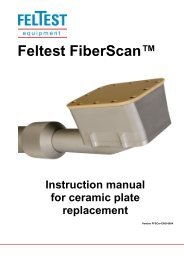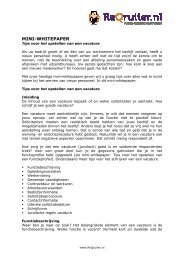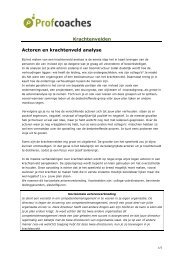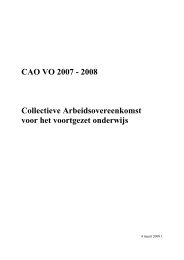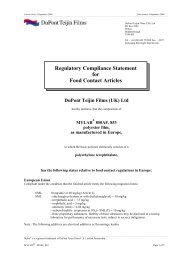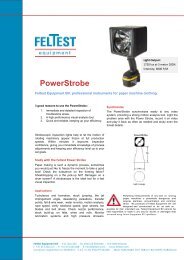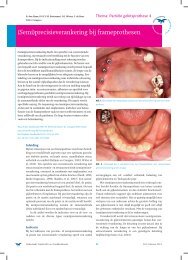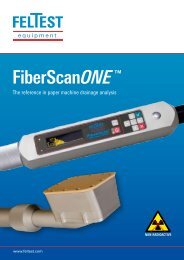Newborn screening in Europe Expert Opinion document
Newborn screening in Europe Expert Opinion document
Newborn screening in Europe Expert Opinion document
You also want an ePaper? Increase the reach of your titles
YUMPU automatically turns print PDFs into web optimized ePapers that Google loves.
FINAL 28/08/2011discovered and treated very early <strong>in</strong> life”. 45 “If the defect is detected very early <strong>in</strong> life mentalretardation can be prevented”. Also galactosaemia is mentioned here, “but, unlike PKU, ifuntreated it leads to early death.”The health burden should be evaluated based on birth prevalence and severity. 46 This firstWilson and Jungner criterium is basically an efficiency question. It is most likely that<strong>screen<strong>in</strong>g</strong> is worthwhile, when there is a good <strong>in</strong>tervention for a severe and relatively frequentdisease. Once a neonatal <strong>screen<strong>in</strong>g</strong> program is <strong>in</strong> place, one could well imag<strong>in</strong>e that <strong>screen<strong>in</strong>g</strong>for a rare and/or not so severe condition could still be cost-effective.EU countries have <strong>in</strong>cluded a diversity of disorders <strong>in</strong> their NBS programs. Congenitalhypothyroidism (CH), PKU, congenital adrenal hyperplasia (CAH), medium cha<strong>in</strong> acyl-CoAdehydrogenase deficiency (MCADD) and maple syrup ur<strong>in</strong>e disease (MSUD) have <strong>in</strong> manycountries been <strong>in</strong>cluded <strong>in</strong> the program as it is clear that these are important health problemswhere an early diagnosis prevents irreparable damage. The same is true for sickle cell disease(SCD)/β thalassemia <strong>in</strong> Mediterrean countries or countries with migrant populations.The frequency of the disorder played a role <strong>in</strong> recent <strong>screen<strong>in</strong>g</strong> debates <strong>in</strong> F<strong>in</strong>land, wherePKU does not occur <strong>in</strong> the <strong>in</strong>digenous population. Migration is chang<strong>in</strong>g the prevalence.Therefore targeted PKU <strong>screen<strong>in</strong>g</strong> is now offered by most of the maternity hospitals <strong>in</strong>F<strong>in</strong>land to people of non-F<strong>in</strong>nish ancestry. Also the frequency of sickle cell diseases (SCD)has changed <strong>in</strong> some populations due to migration (from Africa and Asia), rais<strong>in</strong>g thequestion of targeted <strong>screen<strong>in</strong>g</strong> of an ethnic group and the perception of <strong>in</strong>equality for thoseexcluded or discrim<strong>in</strong>ation of those targeted. F<strong>in</strong>d<strong>in</strong>g the group at risk is not alwaysstraightforward. A population-wide approach m<strong>in</strong>imizes these problems. There appears to bea grow<strong>in</strong>g consensus that ethnically targeted neonatal <strong>screen<strong>in</strong>g</strong> is not an acceptable publichealth strategy. 47In the current age of high throughput technology, a relevant question is whether each of theconditions <strong>in</strong> a NBS program needs to fulfil the criterion “important health problem”.Alternatively, a technological development could def<strong>in</strong>e a group of disorders to be identifiedby one technology (such as tandem mass spectrometry: ms/ms). The EUNENBS consideredthat the pros of technology-driven comb<strong>in</strong>ations of disorders could be summarised, but conscount per disorder. There may be reasons to group conditions, especially cost-effectiveness,but this does not detract from any requirement for each <strong>in</strong>dividual condition to adhere to theprerequisites that there must be effective <strong>in</strong>terventions as well as good test performance, fewadverse effects on the unaffected population and adequate services to look after the children. 48A responsible evaluation per disease is thus needed. Screen<strong>in</strong>g should only occur when it iscl<strong>in</strong>ically relevant. It was acknowledged by EUNENBS however that it is difficult to def<strong>in</strong>ethe threshold for whether <strong>screen<strong>in</strong>g</strong> of a disorder is cl<strong>in</strong>ically relevant.Perform<strong>in</strong>g a <strong>screen<strong>in</strong>g</strong> program will help to better understand all aspects of a disorder. Theevaluation of the Wilson & Jungner criterium #7 may thus change after the start of a<strong>screen<strong>in</strong>g</strong> program as new <strong>in</strong>formation becomes available.45 http://whqlibdoc.who.<strong>in</strong>t/php/WHO_PHP_34.pdf (page 27).46 Charter of fundamental rights of the <strong>Europe</strong>an Union, art 35. Amsterdam Treaty of the EU, Art 16847 Grosse SC, Olney RS, Baily MA. The cost effectiveness of universal versus selective newborn <strong>screen<strong>in</strong>g</strong> forsickle cell disease <strong>in</strong> the US and the UK. Appl Health Econ Health Policy 2005;4:239-247.48 Burton H, Moorthie S. Expanded newborn <strong>screen<strong>in</strong>g</strong>. A review of the evidence. Cambridge, PHG Foundation,2010.25




